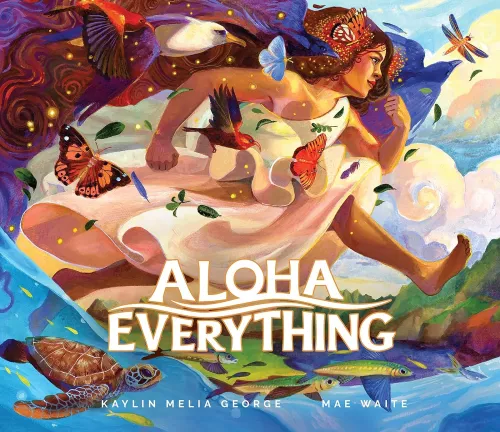Share this book
In Aloha Everything, readers learn how the word aloha can be used and interpreted in many different ways, including as a way to give love and affection, offer kindness and compassion, or give greetings and farewells. Talk with students about how these different meanings are woven into the book. How does hula help the girl connect with aloha? What does “aloha everything” mean? Where does aloha come from? How do you give aloha to all?
Ask students to think about how they give love to others and honor all people and the natural environment. How can their thoughts and feelings of love and respect become actions?
Then, have them use art to express their ideas and to encourage everyone to give love and respect to themselves and others. Plan a collaborative mural, banner, or bulletin board around the theme of aloha, allowing students to contribute a work of their own to something larger. Give them time to pour over illustrator Mae Waite’s lush paintings for artistic inspiration before they pick up a paintbrush. Talk about where they see aloha in the illustrations. Brainstorm together where and how to collectively display their paintings that represent things they are going to do to give aloha to all.
Questions for Discussion or Reflective Writing
- What does hula teach the young girl? What did hula teach you?
- What ideas about what hula is did this book change for you? How is hula different from dances or performance traditions from other cultures? What else is part of the practice of hula?
- Hula is the way Native Hawaiians have passed down stories and legends throughout the ages. What are some other ways to share stories? How does your family share stories about your ancestors and your culture?
- How do you feel about the place where you were born or where you now live? How do the place you live and the people that surround you shape who you are as a person? What role does land play in your identity?
- What do you know now about Hawai'i that you didn’t know before reading Aloha Everything?
- How did the illustrations help bring the text to life? How does the art do its own storytelling?
Related Resources
I-Spy in Aloha Everything Worksheets from Red Comet Press
“Invitation to Imagine” activities from Kaylin Melia George and Mae Waite at TeachingBooks.net
Resources from the Hula Preservation Society
Create a Collaborative Mural from Kids Gardening
More Titles to Try
Stay on top of current education news



